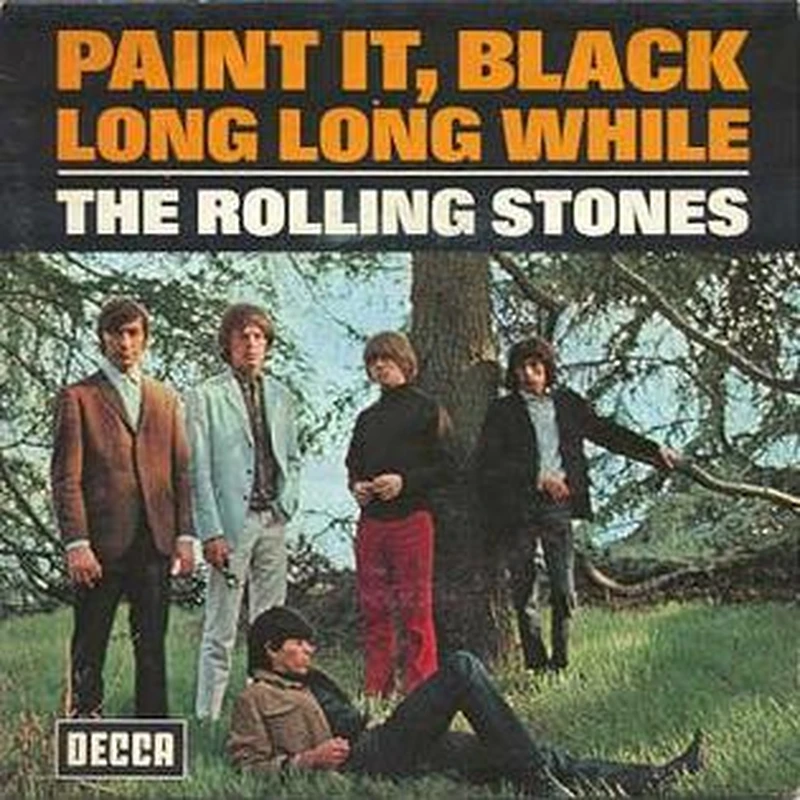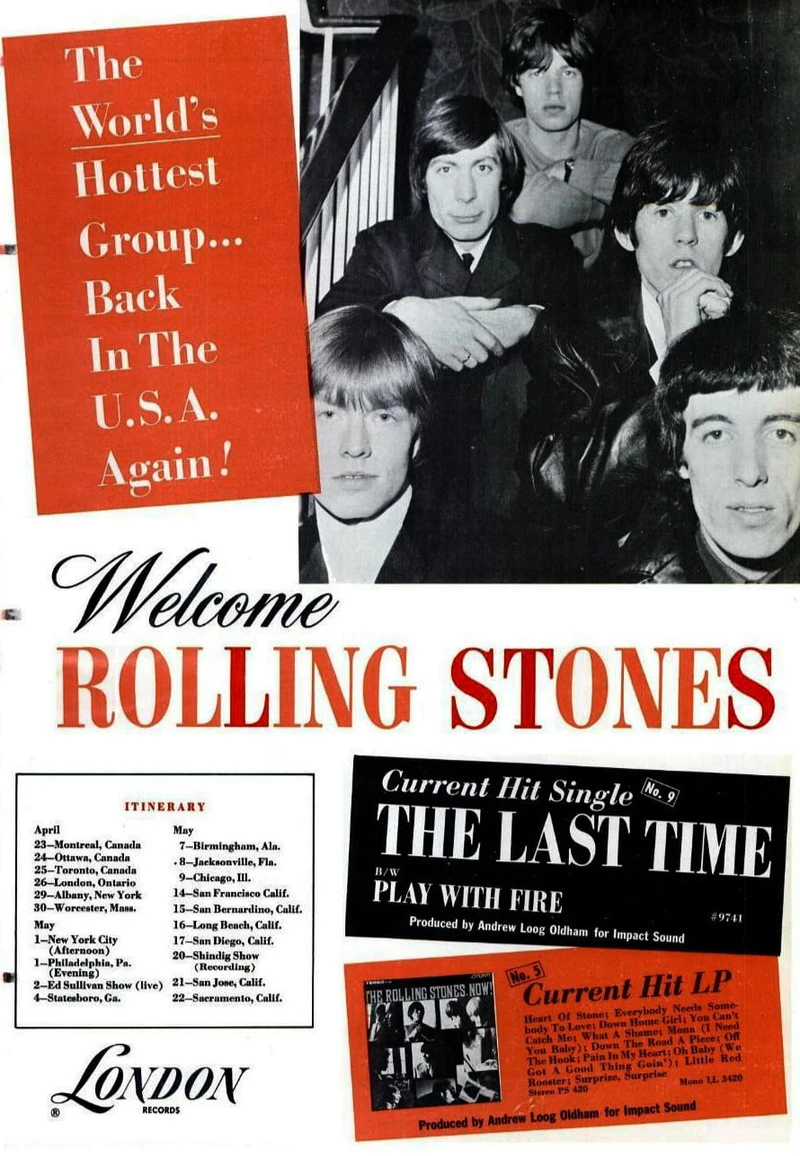In Tim Burton’s popular youth series Wednesday, there is an episode where the main character, Wednesday Addams, plays the melody of The Rolling Stones’ Paint It Black on a cello from the balcony of her room at Nevermore Academy. This instrumental motif perfectly matches the mood of the show and the character’s image, just like the cello and other equally atmospheric instruments that have been used at different times for its performance.
The song—a musical riddle whose meaning is still debated—was recorded in spring 1966, and since then, over a hundred diverse versions have been documented.

The cover of the single Paint It Black, whose title was mistakenly printed with a comma by the releasing label Decca.
Let’s try to break down its components.
“Paint It Black” performed by Wednesday Addams
Sitar
The classical Indian plucked instrument was popular among 1960s rock musicians who, eager to follow the then-fashionable fascination with Eastern culture, added exotic flair to their works and enhanced their psychedelic sound.
A key popularizer of the sitar and Indian culture in the rock scene was The Beatles’ guitarist George Harrison, who later embraced Hinduism. He became the first rock musician to use this instrument in popular music — notably in The Beatles’ 1965 song Norwegian Wood (This Bird Has Flown). Given the strong competitive, and sometimes rivalrous, relationship between the two bands, the Indian sitar sooner or later also appeared in The Rolling Stones’ compositions.

North American Tour, 1965
According to one version, the main sitar theme that set the tone for the future hit was born after George Harrison met Rolling Stones guitarist Brian Jones. In fact, as early as the early ’60s, Jones studied sitar under Harihar Rao, a disciple of Ravi Shankar, the most renowned master of the instrument.
Incidentally, Rao played a significant role in the song’s fate, as one story goes, he entered the studio with his instrument just as the track was being mixed.
This video vividly demonstrates Brian Jones performing the song on sitar:
Vietnam
Stanley Kubrick’s penultimate film, Full Metal Jacket (1987), like Francis Ford Coppola’s Apocalypse Now released a bit earlier, stands as one of cinema’s most powerful expressions of the horrors of war—specifically, the Vietnam War. The film depicts how young men are not so much toughened by military training as transformed into cold-blooded killers sent to a foreign land. Throughout the end credits and until the very conclusion, the Rolling Stones’ song Paint It Black plays, and from that moment, it has often been associated both with the film and the Vietnam War.
There is logic in this connection: the song was written in 1966, when the active phase of the American invasion was intensifying and anti-war sentiments were spreading worldwide. Artists, especially rock musicians, were then thought leaders, and The Rolling Stones’ popularity in the US was rapidly growing. The main riff of Paint It Black was written in a Los Angeles studio. And even if the song’s meaning wasn’t directly about those events, many Vietnam War veterans have said it supported them during those years and best captured the fighting spirit they needed.
Official lyric video for the song:
World Literature
As is well known, another Rolling Stones song, Sympathy for the Devil, released two years later, was inspired by the poems of Baudelaire and Bulgakov’s novel The Master and Margarita. Which specific literary work influenced the creation of Paint It Black remains uncertain, as the song’s authors—Mick Jagger and Keith Richards—never explicitly named their “influencers,” possibly due to the song’s age.
Some claim it was inspired by British occult writer Dennis Wheatley, while others mention Edgar Allan Poe, Bob Dylan, and even avant-garde artist Ed Reinhardt. According to other sources, Mick Jagger drew inspiration from the famous modernist novel Ulysses by Irish writer James Joyce, specifically a passage containing the words: “I must turn away before my darkness goes away.” These are the words spoken by the song’s protagonist when he encounters girls in summer dresses.

The Rolling Stones Concert, 1981. Photo: Michael Conen
Gypsies and Weddings
In one interview, Mick Jagger jokingly called Paint It Black “a song for Jewish weddings.” In another conversation, he compared it to certain Turkish songs. But what influences dominate the song—Middle Eastern, Indian (thanks to the exotic instrument), or perhaps Romani (Gypsy), as some members of that community claim?
American musicologist James Perone noted that despite the sitar intro played in an Indian style, the song’s rhythmic and melodic feel is more reminiscent of the Middle East. The search for the right form reportedly led Rolling Stones member Bill Wyman to almost pound the Hammond organ with his fists during recording, holding it on his lap. This inspired the band toward a fast tempo and Eastern pentatonic scale.
Overall, the song presents a paradox: although its content deals with hopelessness, depression, and despair, and it is considered one of rock music’s darkest works, it’s easy to imagine it playing at a private Middle Eastern party, where its accelerated tempo unmistakably invites dancing.
Perone suggests the song’s protagonist’s depressive state and despair pushed him to a point where he embraces a “to hell with it all” attitude. The mention of Gypsies is fitting because their constant contrast—combining desperate suffering with relentless joy—is embedded in the song’s concept.
However, the “Gypsy parallels” in Paint It Black lie elsewhere: some listeners have identified motifs from Djelem Djelem, considered the official anthem of the Romani people (adopted in 1971 at their World Congress). Indeed, if you imagine the song played at twice the speed, the similarity becomes clear. Listen for yourself:
Color Palette of Emotions
In fact and meaning, the song Paint It Black is about how a person who has just lost a loved one perceives the world around them: inner grief drives them to turn away from girls in light dresses, to watch black cars adorned with decidedly unfestive flowers, and wrestle with an unbearable urge to paint everything black—even the brightly shining sun.
As expected, the song has sparked an incredible amount of conspiracy theories, speculation, and original interpretations of its metaphors.
For example, the line “I see my red door, I must have it painted black,” referring to mysterious red doors, was interpreted quite unexpectedly: traditionally, Anglican church doors in the UK were painted red, leading to the idea that the song’s protagonist, in his despair, is turning away from God. Some saw red as a symbol of the communist threat, while others thought it referred to the entrance to brothels.
Certain lines of the song and their color references remain debated on Internet forums and fan sites. One of the most surprising theories heard is that the song is dedicated to Jacqueline Kennedy, as the tragedy involving the American president shortly before was indeed a global shock.
Most likely, however, the young Jagger and Richards did not intend any specific or hidden meanings in the lyrics and have spent the following decades ironically observing the cascade of interpretations and flights of fancy inspired by the song.

The Rolling Stones Concert in London, 2018. Photo: Raph_PH
Versions
This truly popular song has been performed in many languages around the world — from Finnish to Japanese. Each rendition is interesting and colorful in its own way. Here is, for example, a version by French singer Marie Laforêt:
And here is an equally eccentric and candid performance by the Italian singer Caterina Caselli:
However, it seems that the popular Czech singer Karel Gott performed the song best, delivering the hit in German with an orchestral arrangement that blends both Romani melancholy and lively dance rhythms.
